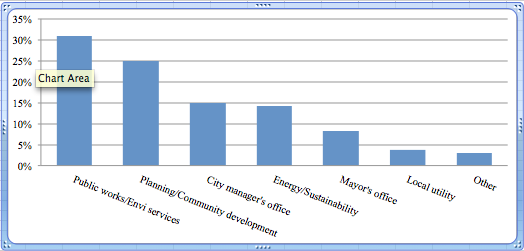Study: How cities elect council members affects sustainability initiatives

LAWRENCE — Although the influence of local interest groups often receives attention, how cities elect council members may be key to how they organize sustainability initiatives, according to a new study led by a University of Kansas professor.
 "With every additional council member that is elected by district, the likelihood that a city has a specialized sustainability unit increases," said Rachel Krause, assistant professor in the School of Public Affairs and Administration.
"With every additional council member that is elected by district, the likelihood that a city has a specialized sustainability unit increases," said Rachel Krause, assistant professor in the School of Public Affairs and Administration.
Krause said the study was notable because it provides the first detailed look at the organization of sustainability initiatives at the city level, and the research team determined that almost 65 percent of mid- and large-size American cities with more than 50,000 people have some form of specific initiative aimed at environmental sustainability or climate protection.
"Local governments in the United States have been some of the primary innovators in sustainability policy for close to a decade, and I think that is not widely recognized," Krause said.
Krause was lead author in the study "The Administrative Organization of Sustainability Within Local Government," which was published recently in the Journal of Public Administration Research and Theory. Co-authors were Richard Feiock, KU alumnus and professor in the Askew School of Public Administration and Policy at Florida State University, and Christopher Hawkins, associate professor in the School of Public Administration at the University of Central Florida. The London School of Economics and Political Science also published a blog about the study.
Krause said the finding that council members elected by district instead of at-large seemed counterintuitive at first because representatives who serve an entire city instead of one district have greater incentive to promote issues that benefit the community as a whole. But instead, the researchers discovered that cities with a larger percentage of council members elected at-large are significantly less likely to have a specialized sustainability unit in the city, which is typically associated with an increased effectiveness of those initiatives in a city.
She said because sustainability is often put into place on a project-by-project basis, cities that have more advanced initiatives may have the backing of council members who served a certain area of the city.
"District-based elections may lead to a better representation of the 'environmental minority interest,'" Krause said. "Many cities have distinct areas or neighborhoods that have a 'new urbanist' or 'smart growth' character, and residents who value the environment and sustainability may self-select to live in these issues. Such concentrations increase the likelihood of electing a representative whose priorities reflect those values."
Another key to the study was analysis of the administrative placement of sustainability efforts, particularly whether the sustainability initiative was given its own office or placed within a certain existing city department. Krause said sustainability administration and coordination is most often placed within the public works or environmental services departments.
Among the 450 cities in the study with sustainability initiatives, about 30 percent designated the public works or environmental services departments with primary responsibility for the initiative. Planning or community development departments accounted for the second-highest rate at 25 percent. About 15 percent of cities placed sustainability initiative in the city manager's office and 8 percent in the mayor's office. Additionally, nearly 7 percent of cities housed sustainability initiatives either through a local utility or some other office within the government.
Only 15 percent of cities had created an independent office or department of sustainability, which Krause said seemed to be the most effective at implementing sustainability initiatives that either don't apply narrowly to a specific department or get wrapped into an existing department's mission.
"This arrangement often reflects the highest level of local support and prioritization," she said.
Krause said future research would focus more on best practices for sustainability initiatives.
"In the short term, however, local governments are encourage to put strategic thought not only into what types of sustainability initiatives to pursue," she said, "but also into how and where they should be administrated from within the city government organization."
A video about Krause's research is available here.